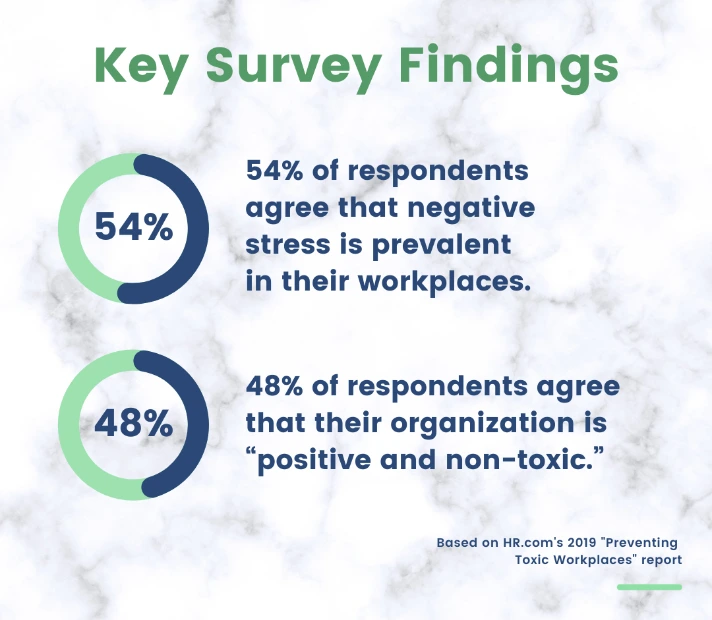
A toxic work environment is the worst nightmare for any business, creating an unpleasant atmosphere for employees. It severely hampers productivity, leads to high employee turnover, and devastates profit margins.
A study conducted by Rand Corp interviewed 3,066 workers in the United States, revealing that over half of them experienced unpleasant conditions in their workplaces.
Furthermore, the Society for Human Resources Management (SHRM) conducted a literature review in 2019, highlighting that the turnover cost attributed to workplace culture exceeds $200 billion.
The effects of a toxic work environment are evident and overwhelming, making it crucial to recognize the signs early on in order to address the issue promptly. Understanding keywords such as toxic work environment, toxic work culture, how to deal with a toxic work environment, toxic workplace, and toxic environment at work can be helpful.
How to Fix a Toxic Work Environment
Fixing an unpleasant workplace culture can be challenging, but it’s certainly doable. Unfortunately, not many organizations are proactively building a healthy work culture.
According to a research from HR.com, only 50% of workplace leadership take actions to fix a toxic office environment. This is partly because management lacks the necessary skills to do so.

As a leader, it is your responsibility to observe, investigate, and resolve the issues which make your organization hostile.
The steps in this article serve as a guide on what you should do. Make sure you streamline the methods to fit your company’s needs.
Now without further ado, let’s get started with 13 actionable tips on how to fix a toxic work environment!
1. Start at the Leadership Level
Most times, you have to start cleaning the house from the top. It’s hard to accept, but your toxic workplace could very well be a reflection of your leadership.
Here are signs that show your organization’s leadership is fueling toxicity:
- A command culture and micromanagement
- Lack of accountability at your organization’s highest levels
- Employees are always taking the fall for managerial failures
- Favoritism and discrimination
- Lack of synergy and communication between leaders and the lower levels of the organization
You must curb these ugly trends. First, make sure every leader understands that behaviors deemed unacceptable have severe consequences. If any supervisor or manager fails to adapt, take stringent actions. It should be part of the professional development goals for managers to become leaders that inspire a positive work culture.
2. Reevaluate Your Leadership Style
Sometimes, business owners are easily carried away by the pressures of entrepreneurship that they forget employees see their behavior. If you don’t put your actions in check, your workers could start adapting to how they believe you want them to operate.
For example, if you consistently work more and communicate less, this could spread to become the way things are done in your organization. Other managers could fail to pass on detailed instructions, causing employees to make mistakes and produce undesirable results.
So, make sure you keep your eyes on the ball and not shirk your leadership responsibilities. Improve your communication skills and remember always to inspire others to do better. Don’t be isolated in your office space all day. You want to be a transformational leader that inspires others through your work ethic.
3. Find out Why Your Workplace Is Toxic
The cause of the problem determines the right approach. So, you can’t fire employees just because they’re involved in conflicts or reshuffle team members and expect the dust to settle. You won’t know how to change a toxic work environment without understanding why it’s the way it is.
To get to the root of the issue, consider getting involved with your employees’ day-to-day. For example, integrate yourself into teams to find out what goes wrong and how. You can also carry out one-on-one meetings and send out surveys to get your staff’s opinions about what has gone wrong.
Hiring an expert human resource manager to investigate the cause of your dysfunctional workplace is another way to go.
4. Inspire a Positive Work Behavior from the Beginning
If you haven’t already, you should start taking measures to prevent a toxic work environment. Even if you’re implementing a fix, you want to ensure new hires aren’t introduced into an unconducive workplace.
Recruit the Right Team
Start by ensuring you hire the right people. Look beyond talent and conduct thorough background checks before interviews. Make sure you find out why they left their former jobs and understand their relationships with former co-workers and employers. Take notes of comments from referees and read between the lines.
During interviews, ask strategic questions like their views on specific issues and how they’ll approach conflicts.
Inform New Hires About the Work Culture
Before new hires walk through the door, share your company’s values and culture. Then, walk them through your anti-harassment, conflict resolution, and grievance policies. Let them understand that they’ll always be listened to, but they must know about the consequences of false allegations.
5. Define Unacceptable Behavior
Don’t mince words about what your company considers improper and unacceptable behavior. Businesses begin to fail when clear communication goes out the window.
So, be transparent about what you consider appropriate and inappropriate conduct. This way, employees can call out their co-workers and know when they’ve gone wrong. Show them behavioral guidelines during induction, but it shouldn’t end there. The list should be available and talked about regularly.
You can organize behavioral training sessions from time to time and place the guidelines where their eyes will always meet them. For example, you can place the list next to the coffee maker in a physical office environment. A banner can be pinned to the side of your company’s internal blog, where employees receive updates.
6. Encourage Feedback
Encourage your employees to speak up whenever they notice unruly behavior. Teach them first to confront the co-worker and show them the company’s definitions of unaccepted behavior. Then, if nothing changes, they should report to management. Of course, you also have to ensure that every whistleblower is well-protected.
A report by Emtrain found that 83% of the 40,000 respondents wouldn’t report cases of harassment that they see. In addition, 41% admitted low confidence in management’s ability to do anything about workplace harassment complaints.
So, build their confidence by consistently getting to the bottom of complaints. Don’t leave any issue brought to management unresolved. This way, employees are motivated to report toxic conduct early.
7. Create a Definite Procedure for Reporting and Resolving Grievances
Whenever any employee experiences harassment, there should be a clear path to dealing with the issue. From reporting the incident to investigating and fixing it, a well-defined process must be in place.
Firstly, create the process in a way that employees are not afraid to come forward. Make everyone understand their voices will be heard, and you’ll follow due process. Don’t cut corners in trying to clear up the issue. Ensure the process thoroughly uncovers every stone.
Once you’ve built the procedure, train your employees on how to use it. Let them understand the different stages of the grievance process and how important it is to follow them accordingly.
8. Provide Training on How to Deal with Harassment
Helping your employees understand how to deal with harassment is one way to build a positive work environment. Organize training to teach them how to recognize hostile behaviors, approach negative co-workers, and support other victimized employees. They should also learn how to improve the work environment by monitoring and assessing adverse situations and ensuring compliance with your anti-harassment policies.
9. Encourage Growth
Investing in your employee’s career growth is a sure-fire way to boost your downlines. However, facilitating development involves a lot of things.
Start by allowing workers to make mistakes and don’t make them feel ashamed of their errors. Let them know it’s alright to be off the mark once in a while, emphasizing that learning from mistakes is essential.
While you do this, however, please do not make it seem like you’re tolerating one employee more than others. Know when to dole out gentle criticism and outright censure.
10. Institute a Culture of Accountability
While you want to encourage workers to learn from their mistakes, you have to teach them responsibility. Make sure underperformers don’t go scot-free. Point out where they err and give them a time frame to fix their shortcomings.
You don’t want hardworking employees to see lazy co-workers get a free pass all the time.
You need to be thorough and determine which team member is deliberately refusing to throw in their weight. Such workers could easily poison others to lag, especially when they aren’t brought to book for their actions.
If they can’t change, you have to let them go.
11. Pursue Transparency
Many companies are still holding on to the code of secrecy. The fear that certain information becomes dangerous when employees hear about it can make leadership keep things from staff.
If this is how your company operates, it’s time for a change.
Employees no longer like being kept in the dark, especially when it comes to issues that should be general knowledge. It breeds a sense of distrust and discredits whatever faith you claim to have in them. This could easily lead to rumors and murmurings, paving the way for other unruly behavior.
Keeping them in the loop about important matters can strengthen your bond and boost morale. It will flatten unnecessary company hierarchy, encourage goal setting, and make everyone happy. In addition, when workers know about critical business operations, they feel more connected to the company and understand that they’re part of the team.
That said, some information is best kept confidential, and every professional understands this. When you can, it would be best to communicate why some data is saved to management alone. Also, ensure you review information tagged confidential to confirm it’s in your company’s best interest to keep them private.
12. Organize More Reward and Recognition Programs
You might be risking an unhealthy work environment by not recognizing the input of your hardworking employees. Instead, try to reward diligent and dedicated workers whenever you can in the form of promotions, raises, and company-wide accolades.
Employees will put in more work when there’s a defined bonus and reward scheme for good performance. It’s also good company culture since it encourages everyone to do their best, not just the natural hard workers.
Without these reward schemes, you’ll have employees who are phoning it in because there’s just no motivation to do more.
Make sure you also acknowledge and reward overworked staff. For example, you can repay their doggedness with an all-expense-paid trip for a well-deserved vacation or give them extra time off.
Retirees should also be rewarded. Make it your company’s culture to throw the best send-off parties packed with gifts and accolades. This way, those still in the workforce know their careers will be crowned with honor in the end.
You can get creative with rewards. It doesn’t have to end at promotions and raises. Sweet parking spots, public acknowledgments, and office upgrades are other ways to recognize and reward hard work.
13. Promote Teamwork
A less collaborative and individualistic workforce opens the door to a toxic work environment. Conversely, cultivating a culture of teamwork makes everyone see achievements as collective rather than individual.
To promote teamwork, allow workers to:
- freely express themselves,
- set realistic goals,
- fix their mistakes,
- receive rewards as a group,
- and experience a fun ambiance.
When everyone gets along, the company’s culture will remain positive.
Signs Your Workplace Is Becoming Toxic
A hostile work environment is the product of negative social conduct and work behavior. It includes anything from physical assaults, offensive jokes, and racist actions to sexual harassment, aggression, violence, and gender discrimination.
Toxicity in a workplace breeds and grows over time. It ends up engulfing the environment if it isn’t resolved in time. Some of the signs of onset workplace hostility include but are not limited to:
- Gossips, murmurings, and rumors
- Bullying
- Snide comments
- Laziness and dereliction of duty
- Declining productivity
- Absenteeism
- Lack of collaboration
- Lack of transparency
- Low morale
None of these situations exemplify a conducive work environment. The more they’re tolerated and become prevalent, the closer your company gets to imploding.
The best thing to do is figure out the cause of these problems and resolve them as soon as possible.
Maintaining a Healthy Work Culture
Now that you know how to fix a toxic work environment, you have to learn how to keep it that way. Fixing the problem is only the first step.
Remember that you should start by inspiring positive work behavior right from the interview level. Then, don’t hesitate to drop prospective hires with a history of toxic behavior.
Keep on training your staff on your grievance procedure and how to handle harassment. Remember to maintain a healthy leadership policy and always assure your team you’ll take action about their concerns.
Most importantly, communicate with your team and have brainstorming sessions on making things better going forward.



